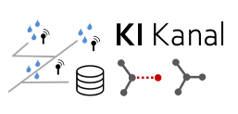Current projects
PRiuS 2022-2027
 The aim is to develop a forecasting/prediction tool for risk assessment and minimization of urban pollutant discharges into water bodies. In a first step, an ML-based model will be developed which will be trained using classical sewer network models to quantify emissions (e.g. E.coli, AFS, etc.) from the urban area by means of easily measured or derived parameters (e.g. precipitation, surface cover, etc.). In addition, an overlay with the expected discharges in the receiving water, including risk assessment, is to be implemented. A digital twin will be developed in order to optimize data transfer and, if necessary, implement synthetic control of the sewer network to minimize risk. As an example for the study area, the methods developed are to be transferred into practice using dashboards as a decision support system with stored models. The urban area of Celle with the Aller river as receiving water serves as the study area.
The aim is to develop a forecasting/prediction tool for risk assessment and minimization of urban pollutant discharges into water bodies. In a first step, an ML-based model will be developed which will be trained using classical sewer network models to quantify emissions (e.g. E.coli, AFS, etc.) from the urban area by means of easily measured or derived parameters (e.g. precipitation, surface cover, etc.). In addition, an overlay with the expected discharges in the receiving water, including risk assessment, is to be implemented. A digital twin will be developed in order to optimize data transfer and, if necessary, implement synthetic control of the sewer network to minimize risk. As an example for the study area, the methods developed are to be transferred into practice using dashboards as a decision support system with stored models. The urban area of Celle with the Aller river as receiving water serves as the study area.Kanaldetektive 2023-2026
KI-Kanal 2022-2025
 The core element of the project is a so-called Internet of Floods (IoF). This is intended to use artificial neural networks (ANN) to improve forecasting and early warning systems for the operational optimization of sewer network control and hazard prevention in the drainage system. A novelty of the proposed approach is its independence from uncertain precipitation forecasts. KI-Kanal is being developed using the Osnabrück drainage system as an example and is also being tested directly under real conditions. In the event of a heavy rainfall event, real-time data on precipitation and water levels in the sewer network are recorded and sent to the IoF via LoRaWAN sensors. They serve as input data for a previously trained ANN. The ANN is designed to output the optimum channel control, discharge and water level forecasts at unobserved points and, if necessary, local network failures. Optimum channel control minimizes the risk of flooding.
The core element of the project is a so-called Internet of Floods (IoF). This is intended to use artificial neural networks (ANN) to improve forecasting and early warning systems for the operational optimization of sewer network control and hazard prevention in the drainage system. A novelty of the proposed approach is its independence from uncertain precipitation forecasts. KI-Kanal is being developed using the Osnabrück drainage system as an example and is also being tested directly under real conditions. In the event of a heavy rainfall event, real-time data on precipitation and water levels in the sewer network are recorded and sent to the IoF via LoRaWAN sensors. They serve as input data for a previously trained ANN. The ANN is designed to output the optimum channel control, discharge and water level forecasts at unobserved points and, if necessary, local network failures. Optimum channel control minimizes the risk of flooding.
